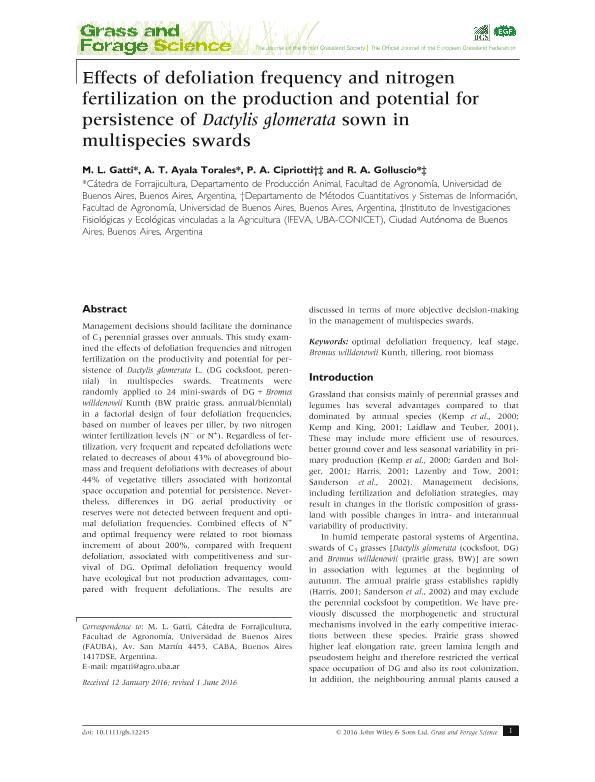Artículo
Effects of defoliation frequency and nitrogen fertilization on the production and potential for persistence of Dactylis glomerata sown in multispecies swards
Fecha de publicación:
09/2017
Editorial:
Wiley Blackwell Publishing, Inc
Revista:
Grass and Forage Science
ISSN:
0142-5242
e-ISSN:
1365-2494
Idioma:
Inglés
Tipo de recurso:
Artículo publicado
Clasificación temática:
Resumen
Management decisions should facilitate the dominance of C3 perennial grasses over annuals. This study examined the effects of defoliation frequencies and nitrogen fertilization on the productivity and potential for persistence of Dactylis glomerata L. (DG cocksfoot, perennial) in multispecies swards. Treatments were randomly applied to 24 mini-swards of DG + Bromus willdenowii Kunth (BW prairie grass, annual/biennial) in a factorial design of four defoliation frequencies, based on number of leaves per tiller, by two nitrogen winter fertilization levels (N− or N+). Regardless of fertilization, very frequent and repeated defoliations were related to decreases of about 43% of aboveground biomass and frequent defoliations with decreases of about 44% of vegetative tillers associated with horizontal space occupation and potential for persistence. Nevertheless, differences in DG aerial productivity or reserves were not detected between frequent and optimal defoliation frequencies. Combined effects of N+ and optimal frequency were related to root biomass increment of about 200%, compared with frequent defoliation, associated with competitiveness and survival of DG. Optimal defoliation frequency would have ecological but not production advantages, compared with frequent defoliations. The results are discussed in terms of more objective decision-making in the management of multispecies swards.
Archivos asociados
Licencia
Identificadores
Colecciones
Articulos(IFEVA)
Articulos de INST.D/INV.FISIOLOGICAS Y ECO.VINCULADAS A L/AGRIC
Articulos de INST.D/INV.FISIOLOGICAS Y ECO.VINCULADAS A L/AGRIC
Citación
Gatti, María Laura; Ayala Torales, A. T.; Cipriotti, Pablo Ariel; Golluscio, Rodolfo; Effects of defoliation frequency and nitrogen fertilization on the production and potential for persistence of Dactylis glomerata sown in multispecies swards; Wiley Blackwell Publishing, Inc; Grass and Forage Science; 72; 3; 9-2017; 489-501
Compartir
Altmétricas




